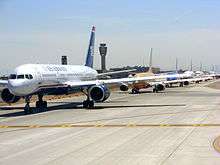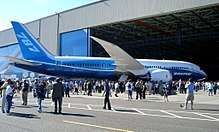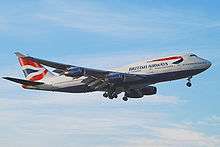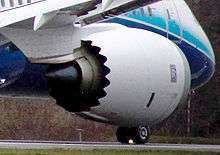Mitigation of aviation's environmental impact
Aviation affects the environment due to aircraft engines emitting noise, particulates, and gases which contribute to climate change[1][2] and global dimming.[3] Despite more fuel-efficient (and therefore less polluting) turbofan and turboprop engines, the rapid growth of air travel in recent years contributes to an increase in total pollution attributable to aviation. In the EU, greenhouse gas emissions from aviation increased by 87% between 1990 and 2006.[4]

At present aviation accounts for 2.5% of global CO2 emissions.[5] Due to projected growth in air travel, in the most technologically radical scenarios for having a better than 50% chance of keeping global warming below 2 degrees Celsius, in 2050 aviation will make up 15% of global CO2 emissions. In more conventional scenarios its emissions will exceed the entire global carbon budget before then.[6] This presents governments and the operators of aircraft with a responsibility to reduce the aviation industry's emissions.
General aviation reduction methods
Some methods aim to mitigate aviation's environmental impact by reducing aviation in general. This can be achieved through various means, such as route optimization, emission caps, short-distance restrictions, increasing taxation and decreasing subsidies.
Route optimization
Currently, air traffic corridors that aircraft are forced to follow place unnecessary detours on an aircraft's route forcing higher fuel burn and an increase in emissions. An improved Air Traffic Management System with more direct routes and optimized cruising altitudes would allow airlines to reduce their emissions by up to 18%.[7]
In the European Union, a Single European Sky has been proposed for the last 15 years so that there are no overlapping airspace restrictions between countries in the EU and so reduce emissions. As yet, the Single European Sky is still only a plan but progress has been made. If the Single European Sky had been created 15 years ago, 12 million tons of CO2 could have been saved.[7]
Emission caps
In the EU, aviation will be including the European Emission Trading Scheme from 2012 onwards. The scheme places a cap on the emissions an aircraft operator can emit and forces the operator to either lower emissions through more efficient technology or to buy "Carbon Credits" from other companies who have produced fewer emissions than their cap. It is thought that this will reduce aviation's net environmental impact.[4]
Short-distance restrictions
In the 2010s and 2020s, several governments have imposed restrictions and even prohibitions on short-distance aviation, stimulating or pressuring travellers to opt for more environmentally friendly means of transportation, especially trains.[8]



Combined train/plane tickets
One way to reduce feeder flights is to make it easier for passengers to buy a combined train/plane ticket.[14] As of March 2019, Lufthansa and Air France already offer this possibility:[16]
- A passenger who books a trip from Cologne to Madrid via Lufthansa is routed to Frankfurt with a Deutsche Bahn train ticket, from where they will fly to Madrid with Lufthansa.[16]
- A passenger who books a trip from London to Strasbourg with Air France only flies as far as Paris, where they transfer to a TGV train to Strasbourg.[16]
In March 2019, Dutch Infrastructure Minister Cora van Nieuwenhuizen stated the government was working on a combined train/plane ticket, so that 'a Mexican wanting to go to Brussels via Amsterdam could book their journey from Mexico via NS International or Thalys in one go,' making an Amsterdam–Brussels flight unnecessary.[14]
Taxation and subsidies
Financial measures can be taken to discourage passengers and airlines from flying in general, and to seek other means of transportation (passengers) or develop more fuel-efficient or less-polluting ways of flying (airlines). The primary means of taxation are:
- Air passenger taxes, paid by passengers to the government for environmental reasons; may be variable by distance and includes domestic flights
- Departure taxes, paid by passengers leaving the country to the government (sometimes also applies outside of aviation)
- Jet fuel taxes, paid by airline companies to the government for the jet fuel (kerosene) they burn
- For the European Union, see Kerosene tax
- For the United States, see Fuel taxes in the United State § Aviation fuel taxes
It's also possible to influence business practices and consumer behaviour by cutting subsidies for unsustainable aviation, or by subsidising the development of more sustainable alternatives both in aviation and other means of transportation wherever aviation can be replaced, such as railway systems.
Methods of mitigating aviation's CO2 emissions
Mitigation of aviation's environmental impact can be achieved through a variety of measures, the most obvious and arguably the most economical of which is to reduce the fuel burn of the aircraft as this accounts for 28% of an airlines costs. However, there is a wide variety of other options available to minimise aviation's growing impact upon the environment as are listed below:[7]
Aircraft efficiency

As stated previously, reducing the direct fuel burn of an aircraft is the most obvious and arguably the most economical way of reducing emissions attributable to aviation. Over the years 1977–2007, commercial jet airliners have become 70% more fuel efficient, and have been predicted to be another 25% more fuel-efficient by 2025 according to Giovanni Bisignani.[7]
The next-generation of aircraft, including the Boeing 787 Dreamliner, Airbus A350 and Bombardier CSeries, are 20% more fuel efficient per passenger kilometre than current generation aircraft. This is primarily achieved through more fuel-efficient engines and lighter airframes & supporting structures made of composite materials but is also achieved through more aerodynamic shapes, winglets, a "one-piece" fuselage and more advanced computer systems for optimising routes and loading of the aircraft. [17]
Biofuels and hydrogen

Biofuels are fuels derived from biomass material such as plants and waste. Plant derived biofuels offer large savings in CO2 emissions as they absorb Carbon Dioxide and release it as Oxygen when they grow and so in a life-cycle, emissions can be drastically reduced. A number of airlines have operated biofuel test flights including Virgin Atlantic Airways, which flew with one engine operating on a blend of 20% coconut oil and 80% traditional jet fuel, and Continental Airlines which flew with one engine operating on a blend of 44% Jatropha oil, 6% Algae oil and 50% traditional jet fuel. Other airlines to demonstrate biofuels include Air New Zealand and Japan Airlines.[18]
In the Continental Airlines test, the engine running partly on biofuel burned 46 kg less fuel than the conventionally fuelled engine in 1 and a half hours while producing more thrust from the same volume of fuel. Continental Airlines' CEO, Larry Kellner, commented "This is a good step forward, an opportunity to really make a difference to the environment" citing jatropha's 50–80% lower CO2 emissions as opposed to Jet-A1 in its lifecycle.[18]
From 2014 onwards, British Airways, in co-operation with Solena, is going to turn half a million tonnes of waste annually that would normally go to landfill from the City of London into biofuel to be used in the British Airways fleet. Waste derived biofuel produces up to 95% less pollution in its life-cycle and so therefore this measure will reduce emissions by the equivalent of taking 42,000 cars off the road every year. [19]
Airbus hopes to have a commercial jet hydrogen-powered aircraft by the early 2030s.[20]
Improved operating procedures
_at_London_Heathrow_Airport.jpg)
Airlines and airports are looking at ways of reducing emissions and fuel burn through the use of improved operating procedures. Two of the more common ones in operation are a single-engine taxi to and from the runway and the use of a Continuous Descent Approach, or CDA, which can reduce emissions significantly during the operations in and around an airport.[21] Scandinavian Airlines (SAS) is now operating its Boeing 737 fleet at a slower cruising speed to help reduce emissions by 7–8%.[22]
Methods of mitigating aviation's non-CO 2 emissions
Aviation produces a number of other pollutants besides carbon dioxide including nitrogen oxides (NOX), particulates, unburned hydrocarbons (UHC) and contrails. A number of methods to reduce the level of these pollutants follows:
Nitrogen oxides (NOX)
Nitrogen oxides have a far stronger impact upon climate change than Carbon Oxides and are produced in small quantities from aircraft engines. Engine designers have worked since the start of the jet age to reduce NOX emissions and the result is ever reducing levels of nitrogen oxide emissions. For example, between 1997 and 2003, NOX emissions from jet engines fell by over 40%.[23]
Particulates
Particulates and smoke were a problem with early jet engines at high power settings but modern engines are designed so that no smoke is produced at any point in the flight.[23]
Unburned hydrocarbons (UHC)
Unburned hydrocarbons (UHC) are products of incomplete combustion of fuel and are produced in greater quantities in engines with low pressure gains in the compressors and/or relatively low temperatures in the combustor. As with particulates, UHC has all but been eliminated in modern jet engines through improved design and technology.[23]
Contrails
Aircraft flying at high altitude form condensation trails or contrails in the exhaust plume of their engines. While in the Troposphere these have very little climatic impact. However, jet aircraft cruising in the Stratosphere do create an impact from their contrails, although the extent of the damage to the environment is as yet unknown. Contrails can also trigger the formation of high-altitude Cirrus cloud thus creating a greater climatic effect.[23] A 2015 study found that artificial cloudiness caused by contrail "outbreaks" reduce the difference between daytime and nighttime temperatures. The former are decreased and the latter are increased, in comparison to temperatures the day before and the day after such outbreaks.[24] On days with outbreaks the day/night temperature difference was diminished by about 6F° in the U.S. South and 5F° in the Midwest.[25]
In the three days following the September 11 attacks on the World Trade Center in New York City, when no commercial aircraft flew in the United States, climate scientists measured the daily temperature range over 5000 weather stations across the USA. The results showed a 1 ° Celsius change in the average daily temperature range for those days of the year, thus showing contrails do have a significant impact on climate.[3] Potential ways of reducing the impact of contrails on our climate include reducing the maximum cruising altitude of aircraft so high-altitude contrails can not form. Cruising at lower altitudes would marginally increase flight time and increase fuel consumption by 4%.[26]
Methods of mitigating aviation's noise emissions

One of the by-products of an aircraft's engine is noise and this has become an increasingly important issue which is being dealt with through many different methods:
Engines
Next-Generation engines are not only more fuel-efficient but also tend to be quieter with Pratt & Whitney's PurePower PW1000G fitted to the Bombardier CSeries aircraft being 4 times quieter than aircraft currently in service.[27] Engines can also incorporate serrated edges or 'chevrons' on the back of the nacelle to reduce noise impact as shown in this picture.[23]
Improved operating procedures
A Continuous Descent Approach, or CDA, not only reduces fuel burn but also allows airlines to provide quieter approaches for part of the descent to a runway. As the engines are at close to idle power, less noise emissions are produced and combined with new engine technology, the reductions in noise emissions can be large.[21]
Carbon offset
.jpg)
A carbon offset is a means of compensating aviation emissions by saving enough carbon or absorbing carbon back into plants (for example, by planting trees through reforestation or afforestation) to balance the carbon emitted by a particular action. Several airlines have begun offering carbon offsets to passengers to offset the emissions created by their proportion of the flight. Money generated is put to projects around the world to invest in green technology such as renewable energy and research into future technology. Airlines offering carbon offsets include British Airways, easyJet, Continental Airlines, Delta Air Lines, Lufthansa and Qantas although there are many more carriers participating in such schemes.[28][29][30][31]
British Airways' scheme
British Airways' carbon offsetting scheme involves paying a fee dependant on aircraft type, class of travel and distance flown and therefore prices vary. Funds generated are currently awarded to three renewable energy projects around the world: Bayin'aobao wind farm in Inner Mongolia, Faxinal dos Guedes hydroelectric power plant in Brazil and Xiaohe hydroelectric power plant in Gansu Province, China.[32]
Continental Airlines' scheme
Continental Airlines' carbon offsetting scheme involves paying a fixed fee of $2 to cancel out emissions through reforestation. Passengers can also choose to pay $50 for offsetting emissions through renewable energy projects.[31]
Electric aircraft
Technological developments have enabled some small planes to fly on electricity alone. Electric aircraft do not emit greenhouse gases and can be charged with renewable energy. As of May 2020, the largest airplane to make a successful flight (of 30 minutes) was a modified Cessna 208B Caravan, capable of transporting nine passengers and a pilot. The electricity for this flight cost US$6 (£4.80), while conventional fuel for a 30-minute flight would have cost US$300–400 (£240–320). However, current lithium-ion batteries' maximum energy density is 250 watt-hours (Wh) per kilogram (kg), while the energy density of kerosene (jet fuel) is around 12,000 Wh per kg. This means electric planes need to carry relatively heavy batteries and thus have much shorter ranges than fossil-fuelled planes. Therefore, they are currently not an option for long-haul airliners. Experts estimate that large electric planes will not be available before 2040,[33] full electrification of all aviation will not be possible before 2070, perhaps not even within the 21st century, although smaller aircraft are probably good candidates for early adoption.[34]
See also
References
- International Civil Aviation Organization, Air Transport Bureau (ATB) (n.d.). "Aircraft Engine Emissions". Retrieved 2010-05-01.
- Enviro.aero (n.d.). "What is the impact of flying?". Retrieved 2010-05-01.
- Travis, David J.; Carleton, Andrew M.; Lauritsen, Ryan G. (2002). "Contrails reduce daily temperature range" (PDF). Nature. 418 (6898): 601. doi:10.1038/418601a. PMID 12167846. Archived from the original (PDF) on 2006-05-03. Retrieved 2013-10-03.
- "Climate change: Commission proposes bringing air transport into EU Emissions Trading Scheme" (Press release). EU press release. 2006-12-20. Retrieved 2010-05-01.
- Schäfer, Andreas W.; Evans, Antony D.; Reynolds, Tom G.; Dray, Lynnette (2016). "Costs of mitigating CO2 emissions from passenger aircraft" (PDF). Nature Climate Change. 6 (4): 412–417. doi:10.1038/nclimate2865.
- Bows A. (2010). Aviation and climate change: confronting the challenge. Aeronautical Journal. 114:1158:pp.459-468.
- "New York Times - Aviation and global warming", New York Times, 2007-09-20, retrieved 2010-05-01
- Matthias Wabl and Christopher Jasper (9 June 2020). "Airline bailouts point to greener travel—and higher fares". BNN Bloomberg. Retrieved 13 June 2020.
- Gerhard Hegmann (9 June 2020). "Österreich verbietet die 9,99-Euro-Billigstflüge". Die Welt (in German). Retrieved 13 June 2020.
- "MPs propose ban on internal French flights". Connexion France. 3 June 2019. Retrieved 14 June 2020.
- "«Pas de raison de prendre l'avion» pour les trajets inférieurs à 2h30, estime Bruno Le Maire". Le Figaro (in French). 25 May 2020. Retrieved 14 June 2020.
- "'Verbod binnenlandse vluchten onmogelijk'". Algemeen Dagblad (in Dutch). 12 June 2013. Retrieved 14 June 2020.
- L. Tijdink (1 August 2013). "Verslag van een algemeen overleg, gehouden op 12 juni 2013, over Luchtvaart". Regular Commission on Infrastructure and Environment (in Dutch). House of Representatives of the Netherlands. Retrieved 14 June 2020.
A ban on domestic flights, which Ms Van Tongeren asked about, is outside [our] legal possibilities. Under European law, a European airline is free to perform air services within the EU if it complies with all national and international requirements to operate. (...) Discussing a ban on domestic flights on a European level is unwise and impossible. The internal market has been liberalised based on the EU Regulation for European airlines. Member States are not allowed to make the exploitation of air services within the EU depedent upon any permit or permission.
- Judith Harmsen (6 March 2019). "Van Amsterdam naar Brussel vliegen blijft mogelijk". Trouw (in Dutch). Retrieved 13 June 2020.
- Belga (19 August 2019). "Reizigers blijven vliegen tussen Brussel en Amsterdam". De Standaard (in Dutch). Retrieved 13 June 2020.
- Tom Boon (23 March 2019). "More And More Flights Are Being Replaced By Trains To Help The Environment". Simple Flying. Retrieved 14 June 2020.
- Boeing 787 Technology, Boeing, retrieved 2010-05-01
- "A Greener Future?" - Aircraft Illustrated, March 2009
- Solena Video on British Airways biofuel usage, Solena, archived from the original on 2010-05-03, retrieved 2010-05-01
- "Hydrogen could help power new zero-emission Airbus jet". The National. Retrieved 2020-07-23.
- CDA Information (PDF), Civil Aviation Authority (UK), archived from the original (PDF) on 2009-11-13, retrieved 2010-05-01
- SAS reduces cruising speed to reduce emissions, Allianz, retrieved 2010-05-01
- Rolls-Royce - The Jet Engine - ISBN 0 902121 2 35
- Bernhardt, J. & Carleton, A.M. (2015). The impacts of long-lived jet contrail ‘outbreaks’ on surface station diurnal temperature range. Jrnl of Int'l Climatology. Online-early (July).
- Jet contrails affect surface temperatures. Science Daily. June 18, 2015.
- Williams, Victoria; Robert B. Nolanda; Ralf Toumib (November 2002). "Reducing the climate change impacts of aviation by restricting cruise altitudes". Transportation Research Part D: Transport and Environment. 7 (6): 451–464. doi:10.1016/S1361-9209(02)00013-5.
- Bombardier CSeries Statistics, Bombardier, archived from the original on 2011-08-09, retrieved 2010-05-01
- British Airways Carbon Offset Programme, British Airways, retrieved 2010-05-02
- easyJet Carbon Offset Programme, easyJet, retrieved 2010-05-02
- Continental Airlines Carbon Offset Programme, Continental Airlines, archived from the original on 2012-03-02, retrieved 2010-05-02
- Continental Airlines Carbon Offset Schemes, Bloomberg, retrieved 2010-05-02
- British Airways Carbon Offset Schemes, British Airways, archived from the original on December 25, 2009, retrieved 2010-05-02
- "Don't Expect To See Large Electric Planes Until At Least 2040". Simple Flying. 2019-11-28. Retrieved 2020-06-20.
- Chris Baraniuk (18 June 2020). "The largest electric plane ever to fly". Future Planet. BBC. Retrieved 20 June 2020.